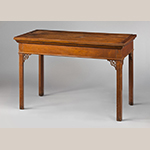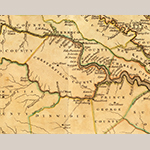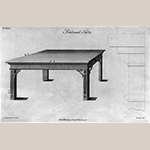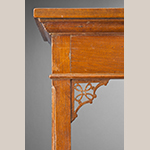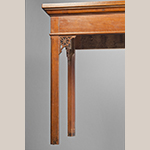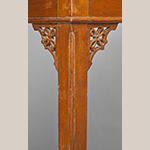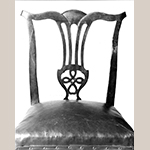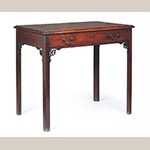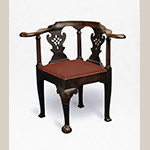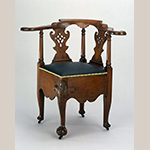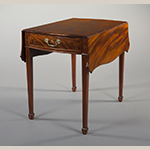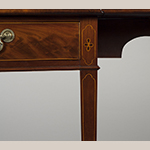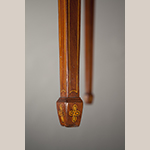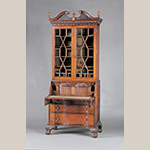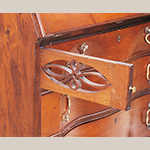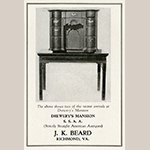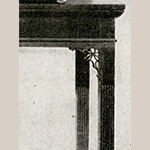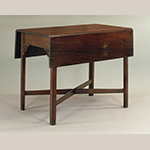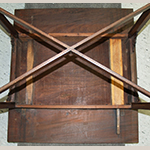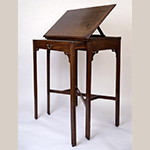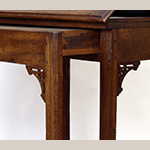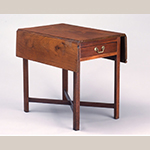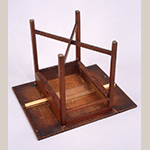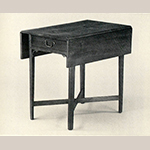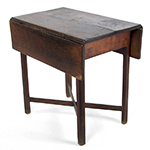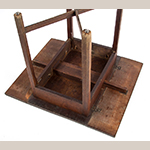The influx of nearly five thousand immigrants annually from Scotland, Ireland, and Northern England between 1700 and 1775 significantly altered the cultural landscape of America’s Chesapeake region.[1] A sideboard table (Figure 1) probably made between 1760 and 1770 is an excellent example of the material influence brought by these immigrants, specifically Scottish cabinetmakers who settled in the central Virginia cities of Richmond and Petersburg. Although the sideboard table is not signed, it provides a starting point from which to build and attribute the first identified grouping of colonial furniture made in this region of Virginia.
The sideboard table was discovered in Chesterfield County, just south of Richmond and northwest of Petersburg (Figure 2) and is derived directly from Plate XXXV in Thomas Chippendale’s 1754 The Gentleman and Cabinet Maker’s Director (Figure 3).[2] Working solely in walnut, the sideboard table’s maker followed Chippendale’s pattern with precision, including the cyma molding underneath the top, the small beaded molding on the apron, and the graceful chamfering of the inner corners of the legs (Figures 4 and 5). Importantly, however, the Virginia cabinetmaker also modified Chippendale’s design with a mitered batten top and a fine bead on the outer corners of the legs. With sprig nails he attached a very distinct quatrefoil bracket to the apron and legs (Figure 6). What influenced the table’s maker to incorporate such diversions from Chippendale’s original design, especially the quatrefoil bracket?
British furniture historian Adam Bowett has recognized the quatrefoil “knot” as a Scottish feature.[3] [4] To support his determination of a Scottish origin for the design, Bowett cited a chair in the collection of the National Museum of Antiquities of Scotland with a quatrefoil knot in the back splat (Figure 7).[5] A similar version of the quatrefoil knot, along with beaded legs, appears on a circa 1759 mahogany writing table (Figure 8) attributed to Alexander Peter, an Edinburgh cabinetmaker who was involved in furnishing Dumfries House in Ayrshire, Scotland.[6] Peter, whose work spanned over forty years, was in part responsible for the most significant collection of documented Scottish furniture surviving today.[7] While the quatrefoil knot may not be uniquely Scottish, it does seem to have been a desired ornament on furniture made in Scotland.
In the American South—specifically the colonies of Maryland and Virginia—the use of the quatrefoil knot can be seen on the furniture of three identified colonial and antebellum cabinetmakers born in Scotland. Robert Walker of Fredricksburg, Virginia, John Shaw of Annapolis, Maryland, and John Shearer of Martinsburg, Virginia all incorporated a version of the knot in their work (Figures 9 through 15).[8] Collectively they used the design between 1735 and 1818, spanning some 83 years. No other ethnic group in America during this period has been associated with the quatrefoil knot design on furniture.
Another sideboard table nearly identical to the one found in Chesterfield County (Fig. 1) was recorded in the MESDA Object Database. This second table is known only through an advertisement placed by J. K. Beard of Richmond in the April 1928 issue of Antiquarian magazine (Figure 16).[9] The table featured the same quatrefoil knot brackets but also added elaborate fluting along the front surface of all four legs (Figure 17).
A breakfast table in the collection of the Colonial Williamsburg Foundation (Figure 18) also displays the quatrefoil bracket—along with a bead down the outside corners of the legs and chamfering on the inside corners of the legs. The table includes an uncommon support for the leaves: A loper or draw bar encased in a yellow pine box attached to the underside of the top (Figure 19). A corresponding opening in the side apron allows the bar to be pulled out to support the leaf rather than the more traditional use of a concealed hinged bracket. This circa 1770 table was acquired from Richmond antiques dealer W. S. Ahern.[10]
A reading table (Figures 20 and 21) in the collection at Monticello reveals similar construction and style characteristics to the sideboard and breakfast tables illustrated in Fig. 1, Fig. 16, and Fig. 18.[11] The reading table has a mitered batten top, all of its legs are chamfered on the inner corners with beads on the outer corners, and it has X-shaped stretchers similar to those seen on the table in Fig. 18. The brackets on the reading table are replacements and appear to have been derived using those that Thomas Chippendale designed for his sideboard table (Plate XXXV in the 1754 edition of the Director [Fig. 3] and Plate LVI in the 1762 edition). The original bracket pattern of the table is not known but could certainly have included a quatrefoil knot or a design similar to other brackets seen in the group. Together, these elements support the inclusion of Thomas Jefferson’s reading table as the fourth member of the cabinetmaking school under consideration. Of most significance to this study, however, on 9 June 1769 Thomas Jefferson wrote to a Richmond cabinetmaker named George Donald and provided instructions for building this reading table.[12]
George Donald was born in 1731 in Aberdeenshire, Scotland and worked in Richmond from 1757 until his death in 1776.[13] He was first identified as a cabinetmaker in a 1761 apprenticeship indenture for Joseph Scott of neighboring Amelia County.[14] Like many Scots, George Donald “made alliances through marriage or business dealings with gentry planter families.”[15] He was a cousin of Patrick Henry and this association can be seen in a letter to Henry from Donald’s sister Margaret where she refers to him as “Cousin” and then proceeds: “Allow me to put you in mind that I am still numbered amongst the living – and would be very happy to hear of you and your whole family.”[16] Donald’s marriage to Dorothea Jones of Williamsburg placed him within the sphere of many of Virginia’s elite such as Thomas Jefferson.[17] In addition to the commission of the reading table, Jefferson mentioned Donald in his memorandum book on 25 June 1757 in regard to a legal matter.[18] Jefferson represented Donald in legal matters at least three more times between November 1757 and November 1770.[19]
With the documentary evidence from Jefferson’s 1769 letter, the favorable comparison of construction and decorative details, the chronology of his career, and the location of his shop, it is possible to attribute these four tables (Fig. 1, Fig. 16, Fig. 18, and Fig. 20) to the Richmond cabinetmaker George Donald.
If tables without a quatrefoil knot are included in the survey, a second breakfast table at Colonial Williamsburg (Figure 22) must also be considered. This table shares a similar support system for the leaves, although this example has a single, central box that contains both lopers instead to two boxes, one for each leaf. It has an X-shaped stretcher system as well as chamfering on the inner corners of the legs (Figure 23), however, the legs are unbeaded.[20] The table dates to approximately 1775 and is attributed to Petersburg, Virginia with a history of ownership in the Harrison family of Prince George County. In Southern Furniture 1680–1830, the use of sliding lopers to support the leaves is noted as a characteristic of Petersburg cabinetmaking.[21] Jonathan Prown identified a related breakfast table (Figure 24) in his 1992 MESDA Journal article “A Cultural Analysis of Furniture-Making in Petersburg, Virginia, 1760-1820.[22] This table has a history in the Ruffin family of Prince George County and includes a simple C-scroll bracket, the boxed loper system to support the leaves, X-shaped stretchers, and chamfering on the inner corners of the legs.[23]
A fourth breakfast table (Figure 25) appeared in an auction at Jeffrey S. Evans in November 2014. This example was previously owned by the Colonial Williamsburg Foundation and was acquired by the museum in 1940 from a family in Colonial Heights, Virginia, a town adjacent to the city of Petersburg.[24] This breakfast table also features the unusual support system for the leaves (Figure 26), X-shaped stretchers, a bead down the outside corners of the legs, and the chamfer on the inside leg corners.
Is there another cabinetmaker who can be associated with this grouping of tables? Possibly one that was working in Petersburg? A search of the MESDA Craftsman Database for cabinetmakers working in Petersburg and surrounding area between 1750 and 1775 revealed approximately twenty candidates.[25] After filtering the search results to identify only those cabinetmakers who would meet all the criteria set forth by these objects—and excluding George Donald—only one strong candidate emerged: Thomas Arbuthnot.[26]
Thomas Arbuthnot, who was almost certainly born in Scotland, is the earliest documented cabinetmaker working in the Petersburg area of Virginia.[27] He was first mentioned in 1765 in the Bristol Parish records providing three inexpensive coffins.[28] In 1766 he advertised from the Petersburg area in The Virginia Gazette for “one or two journeymen cabinetmakers, who are sober and industrious, and understand their business well.”[29] By July 1768 Arbuthnot advertised his intent to leave the colony.[30] Absent from the records for seven years, he appeared again in 1775 in a rented house in Hanover County, north of Richmond.[31] 1776 brought another advertisement that Arbuthnot intended to leave the colony to “journey to South Carolina” for a short time.[32] By 1778 he was residing in Richmond where he placed a notice in The Virginia Gazette for a stolen horse.[33]
Arbuthnot worked in Petersburg, where these three tables (Fig. 20, Fig. 22, and Fig. 23) have histories and likely were made. The two men were working in close geographic proximity and in the same trade. They were both of Scottish origin, each probably from Aberdeenshire. All the evidence suggests that George Donald knew Thomas Arbuthnot. In fact, after George Donald’s death in 1776, his widow, Dorothea, remarried a “Mr. Arbuthnot.”[34] Although his first name is omitted, Arbuthnot is not a common surname in Virginia so it is a strong possibility that Thomas was her second husband. His marriage to Dorothea would solidified his position with the gentry class, just as her earlier marriage had for George Donald.
These seven tables create a grouping of furniture that can be attributed to the cabinetmaking shops of George Donald and Thomas Arbuthnot. Together, they constitute the earliest defined school of colonial furniture associated with the cities of Richmond and Petersburg. These tables establish a Scottish influence on the material landscape of colonial Richmond and Petersburg area. Historians have readily accepted the impact of the Scots on American politics and culture for over a decade.[35] With the discovery of this group of colonial tables, the Scottish influence on America’s eighteenth-century decorative arts can be seen further south in Virginia than ever before.
April Strader Bullin is the Director of Museum Programs at MESDA. She can be reached at [email protected].
[1] David Hackett Fischer, Albion’s Seed: Four British Folkways in America (New York: Oxford University Press, 1989), 608.
[2] Period nomenclature of furniture forms continues to be problematic for decorative arts scholars. For consistency, “sideboard table” has been used throughout this article to describe the table form seen in Fig. 1. Thomas Chippendale used the term “Sideboard Table” in the 1754 (Plate XXXV) and 1762 (Plate LVI) editions of his Director (online: http://digicoll.library.wisc.edu/cgi-bin/DLDecArts/DLDecArts-idx?type=turn&entity=DLDecArts.ChippGentCab.p0084&id=DLDecArts.ChippGentCab&isize=M [accessed 18 April 2016]). In real-world usage, variations of “sideboard,” mahogany or walnut “slab,” and mahogany or walnut “slab table” were employed interchangeably in the mid-eighteenth century, with “slab” seeming to prove more popular in the southern American colonies. For example, a search of the Gunston Hall Probate Inventory Database recorded seven uses of the term “slab” in Maryland and Virginia between 1741 and 1775 while only three instances of “sideboard” during the same period (online: http://www.gunstonhall.org/library/probate/ [accessed 18 April 2016]). In Charleston, South Carolina, Bradford L. Rauschenberg concluded that “the ‘Side Board Table’ and the ‘Sideboard’ as different forms were difficult to understand” within the historic documentation (“Documentary Evidence for Furniture Forms and Terminology in Charleston, South Carolina, 1670-1820,” MESDA Journal, Vol. 34 (2013), entry for “Side Board” [online: https://www.mesdajournal.org/2013/documentary-evidence-furniture-forms-terminology-charleston-south-carolina-ii/#sthash.Unbj3V4N {accessed 18 April 2016}]).
[3] Adam Bowett, interviewed by the author, MESDA, 20 March 2013.
[4] The term “knot” is used throughout this article to denote the dimensionality of the carved and pierced quatrefoil design.
[5] The chair was recorded by Bradford L. Rauschenberg in file B-34 of his 1981 study “The British Influence on American Furniture,” sponsored by The Kaufman Americana Foundation of Norfolk, Virginia and archived in the MESDA Research Center. The chair is in the collection of the National Museum of Antiquities of Scotland, Edinburgh, Scotland, Acc. KNB 17.
[6] Christie’s auction catalogue, “Dumfries House A Chippendale Commission,” 12–13 July 2007, Vol. II, Lot 400 (London: Christie, Manson & Woods, 2007), 234.
[7] Francis Bamford, “Two Scottish Wrights at Dumfries House,” Furniture History, Vol. 9 (1973), 80–87; see also, Clive Aslet, “Selling Out,” The Telegraph, 14 April 2007 (online: http://www.telegraph.co.uk/finance/property/3357604/Selling-out.html [accessed 18 April 2016]).
[8] Robert A. Leath, “Robert and William Walker and the ‘Ne Plus Ultra’: Scottish Design and Colonial Virginia Furniture, 1730–1775”, American Furniture, 2006, edited by Luke Beckerdite (Milwaukee, WI: Chipstone, 2006) (online: http://www.chipstone.org/article.php/559/American-Furniture-2006/Robert-and-William-Walker-and-the-“Ne-Plus-Ultra”:-Scottish-Design-and-Colonial-Virginia-Furniture,-1730–1775 [accessed 18 April 2016]); Elizabeth A. Davison, The Furniture of John Shearer, 1790-1820: “a True North Britain” in the Southern Backcountry (Lanham, MD: AltaMira Press, 2011), 9; and William Voss Elder and Lu Bartlett, John Shaw: Cabinetmaker of Annapolis (Baltimore, MD: Baltimore Museum of Art, 1983), 14.
[9] Antiquarian Magazine, April 1928.
[10] Collection of the Colonial Williamsburg Foundation, Acc. 1938-210 (online: http://emuseum.history.org/view/objects/asitem/items$0040:33893 [accessed 18 April 2016]); also recorded in the MESDA Object Database, file NN-1751.
[11] Collection of the Thomas Jefferson Foundation, Acc. 1938-22 (online: https://www.monticello.org/site/research-and-collections/tall-desk [accessed 18 April 2016]).
[12] Thomas Jefferson, James Adam Bear, and Lucia C. Stanton. Jefferson’s Memorandum Books: Accounts, with Legal Records and Miscellany, 1767-1826 (Princeton, NJ: Princeton University Press, 1997), 18.
[13] “Scotland Births and Baptisms, 1564-1950,” George Donald, 6 February 1731 (Skene, Aberdeenshire, Scotland), FHL microfilm 993,360, cited in FamilySearch database (online: https://familysearch.org/ark:/61903/1:1:XYFX-D6V [accessed 18 April 2016]); Deeds, Wills, 1750-1767, Henrico County, VA, p. 517, James Geddy deed to George Donald, 7 November 1757; Will Book No. 2, 1787-1802, Henrico County, VA, pp. 341-343, Will of George Donald, 18 July 1776.
[14] Deeds, Wills, etc., 1750-1767, Henrico County, VA, p. 668, Indenture of Joseph Scott, 2 February 1761. For more documentation of George Donald’s career, see the MESDA Craftsman Database, ID No. 39891 (online: http://www.mesda.org/research_sprite/mesda_craftsman_database.html [accessed 18 April 2016]).
[15] John K. Nelson, A Blessed Company: Parishes, Parsons, and Parishioners in Anglican Virginia, 1690-1776 (Chapel Hill: University of North Carolina, 2001), 93.
[16] Letter from Margaret Donald to Patrick Henry, Esq., 13 April 1790, transcribed in “Virginia Council Journals,” Virginia Magazine of History and Biography, Vol. 33, No. 1 (January 1925), endnote 45, pp. 44-45; further analysis of this letter available online: http://freepages.history.rootsweb.ancestry.com/~klaw/doc/mdonaldltr.html (accessed 18 April 2016). See also, Edward P. Valentine, The Edward Pleasants Valentine Papers (Richmond, VA: The Valentine Museum, 1927), 1664.
[17] L. H. Jones, Captain Roger Jones, of London and Virginia. Some of His Antecedents and Descendants (Albany, NY: J. Munsell’s Sons, 1891), 40-42 (available online: https://books.google.com/books?id=zRlh286SzsMC&pg=PP9&dq=Jones,+L.+H.+Captain+Roger+Jones,+of+London+and+Virginia.+Some+of+His+Antecedents+and+Descendants.+Albany,+N.Y.:+J.+Munsell’s+Sons,+1891&hl=en&sa=X&ved=0ahUKEwjvovPB6ZjMAhXGdD4KHWF2ARMQ6AEIHTAA#v=onepage&q&f=false [accessed 18 April 2016]).
[18] Thomas Jefferson, James Adam Bear, and Lucia C. Stanton. Jefferson’s Memorandum Books: Accounts, with Legal Records and Miscellany, 1767-1826 (Princeton, NJ: Princeton University Press, 1997), 18.
[19] Ibid, 81, 206–207.
[20] Ronald L. Hurst and Jonathan Prown, Southern Furniture 1680–1830: The Colonial Williamsburg Collection (New York: Harry Abrams for the Colonial Williamsburg Foundation, 1997), 227. Colonial Williamsburg Foundation Acc. 1969-185 (also available online: http://emuseum.history.org/view/objects/asitem/items$0040:23778 [accessed 18 April 2016]).
[21] Ibid.
[22] Jonathan Prown, “A Cultural Analysis of Furniture-Making in Petersburg, Virginia, 1760-1820,” Journal of Early Southern Decorative Arts, Vol. 18, No. 1 (May 1992): 77 (online: https://archive.org/details/journalofearlyso1811992muse [accessed 18 April 2016]).
[23] Ibid, 77.
[24] Appreciation is extended to Tara Gleason Chicirda, Curator of Furniture, Colonial Williamsburg Foundation, for bringing the existence of this table to the author’s attention. Jeffrey S. Evans & Associates, 15 November 2014: Americana & Fine Antiques, Lot 483 (online: http://jeffreysevans.hibid.com/lot/17533796/eastern-virginia-chippendale-cherry-pembroke/?q=table&sort=2&ref=catalog [accessed 18 April 2016]).
[25] Search conducted using the MESDA Craftsman Database (online: http://www.mesda.org/research_sprite/mesda_craftsman_database.html [accessed 18 April 2016]).
[26] Criteria for filtering the list of candidates included: looking at cabinetmakers who were working in 1760 (the earlier date placed on the MESDA sideboard table), checking that they were working in the area where the sideboard was believed to be made, and looking at the longevity of the cabinetmaker’s career. See Arbuthnot, Thomas, MESDA Craftsman Database, ID Nos. 750 and 751 (online: http://www.mesda.org/research_sprite/mesda_craftsman_database.html [accessed 18 April 2016]).
[27] A search of “Scotland Births and Baptisms, 1564-1950” for “Thomas Arbuthnot” born between 1720 and 1740 resulted in three potential matches to the cabinetmaker in Virginia, all born in Peterhead, Aberdeenshire, Scotland: the first baptized 30 September 1732 (father named Thomas); the second baptized 22 May 1738 (father also named Thomas); and the third born in April 1739 (father named James) (cited from “Scotland Births and Baptisms, 1564-1950,” FamilySearch database [online: https://familysearch.org/search/collection/1771030 {accessed 18 April 2016}]). Although the Arbuthnot surname appeared with some frequency in England and Ireland during the eighteenth century, the Arbuthnots are considered a Scottish clan with their origins in Kincardineshire and Peterhead, Aberdeenshire (“Arbuthnot Family Crest, Coat of Arms, Name History, and Name Meaning,” online: https://www.houseofnames.com/arbuthnot-family-crest [accessed 18 April 2016]). Aberdeenshire is where George Donald was born (see Endnote 13) and is also where the most celebrated eighteenth-century Philadelphia cabinetmaker Thomas Affleck (1740–1795) was born (see Alexandra Alevizatos Kirtley, “Thomas Affleck: Philadelphia Cabinetmaker—”late of Aberdeen,” in Making for America: Transatlantic Craftsmanship: Scotland and the Americas in the Eighteenth and Nineteenth Centuries, edited by Vanessa Habib, Jim Gray, and Sheila Forbes [Edinburgh: Society of Antiquaries of Scotland, 2013], 45).
[28] Churchill Gibson Chamberlayne, The Vestry Book and Register of Bristol Parish Virginia, 1720-1789 (Richmond, VA: n.p., 1898), 202, 213, 216 (available online: https://archive.org/details/vestrybookandre01chamgoog [accessed 18 April 2016]).
[29] The Virginia Gazette (Williamsburg, VA), 13 June 1766, 3-1.
[30] Ibid, 2 July 1768, 3-2.
[31] Ibid, 17 June 1775, 3-1.
[32] Ibid, 13 January 1776, 3-3.
[33] Ibid, 23 October 1778, 3-3 and 13 November 1778, 3-1.
[34] Jones, Captain Roger Jones, of London and Virginia, 40-42.
[35] See Fischer, Albion’s Seed; Garry Wills, Inventing America: Jefferson’s Declaration of Independence (Garden City, NY: Doubleday, 1978); and Stephen M. Millett, The Scottish Settlers of America The 17th and 18th Centuries (Baltimore, MD: Clearfield, 1998); and Leath, “Robert and William Walker and the ‘Ne Plus Ultra’,” 55.
© 2016 Museum of Early Southern Decorative Arts

